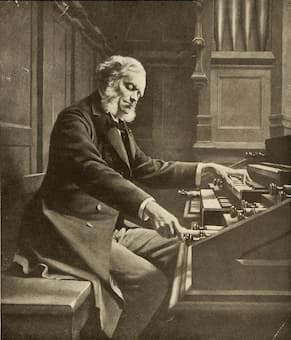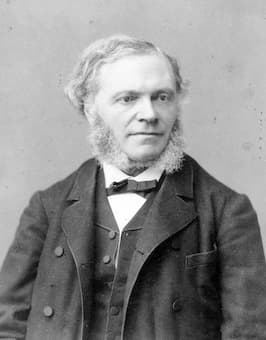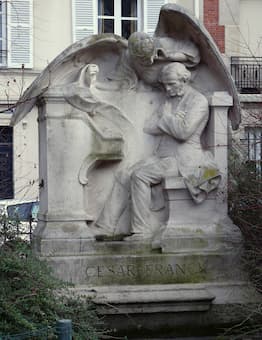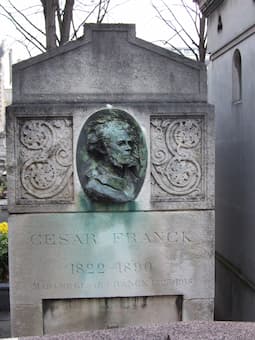
César Franck at the organ
During the early months of 1890, César Franck (1822-1890) was busy on a number of compositional projects, including his String Quartet and the Trois Chorals for organ. Sadly, in July of that year he was involved in an accident. He was riding a cab that was struck by a horse-drawn trolley. The accident caused injury to his head and resulted in a short fainting spell. Nevertheless, Franck was able to continue his journey and he quickly forgot about the incident. “However, walking became painful and he found himself increasingly obliged to absent himself first from concerts and rehearsals, and then to give up his lessons at the Conservatoire.” Taking an early holiday, he did finish the Trois Chorals with scholars suggesting, “Franck was bidding a protracted good-bye… It is hard to believe that Franck retained any illusions about his chances of full physical mending.” He did start the new term at the Conservatoire in October, but caught a cold that turned into pleurisy complicated by pericarditis.
César Franck: Trois Chorals, No. 1

César Franck
His condition worsened rapidly, and he died on 8 November. It had long been assumed that his earlier street injury contributed to his death, but scholars now believe that the respiratory infection by itself could have led to a terminal illness. “Given the then lack of antibiotics, this could not be considered an unusual pattern for pneumonia in a man in his seventh decade.” Franck’s student Louis Vierne remembered the moment when he received word of his teacher’s death. He wrote, “It was as though I had been struck by a thunderbolt—crushed, annihilated. I adored that man who had shown me such tender kindness, who had sustained and encouraged me, inspired in me a profound love of music, and aroused my greatest hopes. And now, suddenly, he was only a shadow, only a memory! I had the horrible feeling of having lost my father a second time.”
César Franck: String Quartet in D Major, M.9 (Petersen Quartet)

César Franck’s house at 95 boulevard Saint-Michel
Much less reverential, Franck’s passing also inspired immediate grabs for his professorship at the Conservatoire. Eugène Gigout, a student of Camille Saint-Saëns, wrote to his old teacher “Do you think that I might be of service as head of the organ class at the Conservatoire?” Charles-Marie Widor launched the same query within 24 hours of Franck’s death, and he would subsequently take over the post.

Monument of César Franck
The funeral for Franck took place at Sainte-Clotilde on 12 November, and was attended by a large congregation including Léo Delibes—as the official representing the Conservatoire—Camille Saint-Saëns, Eugène Gigout, Gabriel Fauré, Alexandre Guilmant, Charles-Marie Widor, Édouard Lalo, and others. Vierne writes, “Going to Sainte-Clotilde, I was as limp as a rag. My poor mother entrusted me to my comrades…in case I should faint during the service…Unbearable distress seized us when, at the offertory, we heard coming from the grand orgue the Cantabile, played too fast and without expression. We had thought that on that day the organ, draped in black, would have remained silent…” Widor quickly identified the offending organist and writes, “the grand orgue…was heard to everyone’s surprise, under the fingers of Monsieur Gigout, whom no one had asked to play.”
César Franck: Les Béatitudes (Louise Lebrun, soprano; Jane Berbié, mezzo-soprano; Nathalie Stutzmann, contralto; David Rendall, tenor; Peter Jeffes, tenor; Marcel Vanaud, baritone; Francois Loup, bass; Daniel Ottevaere, bass; Radio France Choir; Radio France New Philharmonic Orchestra; Armin Jordan, cond.)

Tomb of César Franck
Emmanuel Chabrier gave the funeral oration at the original gravesite at Montrouge. “Farewell, master, and thank you, for you have done well! It’s one of the greatest artists of the century whom we salute in you; it’s also the incomparable professor whose marvelous teaching has furnished a whole generation of forceful musicians, thoughtful and reflective, armed with all weapons for severe and often hard-fought combats; it’s also the upright and just man, so human and so disinterested, who only ever uttered sure counsel and kind words. Farewell…!” Franck’s body was subsequently moved to its current location at Montparnasse Cemetery, into a tomb designed by his architect friend Gaston Redon. A bronze medallion was commissioned from Auguste Rodin by a number of Franck students and places on the side of the tomb in 1893. And in 1904, a monument to Franck by sculptor Alfred Lenoir was placed in the Square Samuel-Rousseau across the street from Sainte-Clotilde. Louis Vierne wrote in his memoir, “Franck was a man of utmost humility, simplicity, reverence and industry… He showed a constant concern for the dignity of his art, for the nobility of his mission, and for the fervent sincerity of his sermon in sound…”
For more of the best in classical music, sign up to our E-Newsletter
César Franck: Symphony in D minor

Excellent article on a great composer whose works are unjustly rarely performed today yet are the most deserving. Surely his death deeply affected those who knew his music well and could appreciate his genius.